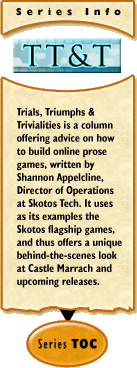 Trials, Triumphs & Trivialities #100: Trials, Triumphs & Trivialities #100:
The Mystique of Game Design: A Photocolumn
by Shannon Appelcline
December 19, 2002 - I've been working for an online game company for close to three years now. And, as the header of this column attests, I've now written a total of a hundred columns on game design for Skotos, somewhere in the league of a quarter of a million words — which is to say, the equivalent of four short novels, or one by Stephen King. That's not the extent of my game design experience either, because shortly before I came to work for Skotos I spent two and a half years editing and laying out books for Chaosium Inc., the publishers of Call of Cthulhu and other innovative tabletop roleplaying games.
Because I'm working in the gaming industry, and have for the most part since 1996 or so, there are some things that are obvious to me that might not be to the average viewer looking in from the outside, and the biggest one of these "obvious" facts is this: designing games is work too.
I'm quite aware that there's a mystique surrounding game design — that it's seen by many game players as the dream job, that which, if attained, leads to joy, happiness, hot chicks, and fast cars. But, really, it's a job.
Personally, I find it a very fulfilling job. I've now stayed with Skotos longer than I have anywhere else I've ever worked. I like the puzzles inherent in figuring out how to put a game together. And I'll admit to just a bit of pride which makes me smile when something I wrote goes out there into the world.
But let me repeat my chorus one more time: it's a job. Four days out of five I spend a lot of time spinning my wheels and dealing with repetitive tasks that aren't particularly exciting — like negotiating business deals or dealing with obsessive ex-customers. Every once in a while I have to do something very not-fun, like write a legal contract. Sure, there are days where I get to program or do web design or develop a game, but they're the minority. Because it's a job.
In this week's column — the last of the year, and my hundredth anniversary — I want to try and do a little bit to raise the veil from the mystique of game design. I want to show you what Skotos really looks like, and what the city outside our doors really looks like. Hopefully it'll help you see a bit more what goes into making computer games live on the net.
I also wanted to do this here, in this hundredth column, to show you what I've been talking about all this time, to bring some closure by means of explanation. If a picture is worth a thousand words, I'll be adding 13,000 of them to the corpus of Trials, Triumphs & Trivialities today.
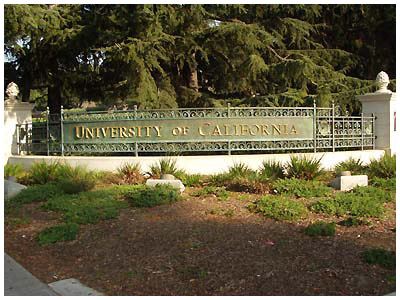
Welcome to Berkeley. As I think I've mentioned before in this column, Skotos is actually located in the city of Berkeley. We're on the north side of the city right now — though we're in the process of moving offices — about six blocks past the University of California. There's a lot of intellectual energy about the campus, a real aura of excitement and innovation, and I think its mere presence helps imbue Skotos with some of that energy. Three of the five people currently working in the Berkeley Skotos office studied at the University too.
|
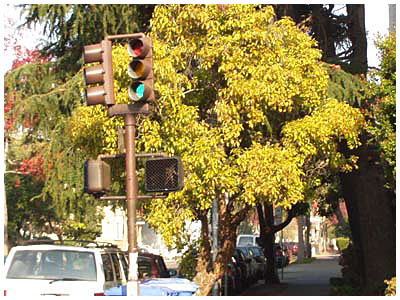
Walking in the Urbs. One of the cool advantages of being in Berkeley is that we're actually square in the middle of a city, not in some faceless industrial park or, worse, in the suburbs. That means we're constantly surrounded by stimuli. Every block there are restaurants, libraries, parks, and stores of all manners. I actually walk to the office, from my house on the other side of the city. By a quick count there are nine bookstores that are within three blocks or so of me at some point during my 1.5 mile trek. I could double that number if I went a mile or so out of my way. It's great for research, and again great for that intellectual energy.
|
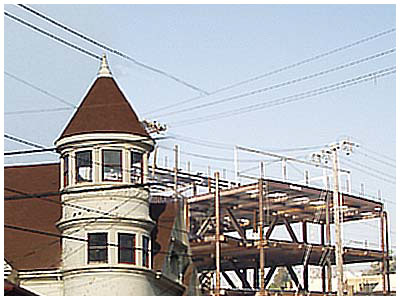
Blending the Old & New. Before I finish rhapsodizing about Berkeley's beauty, I want to mention one last reason I love it: the mixture of the old and the new. On my daily walk into the office I pass by recently built office and school buildings that rise above beautiful old Victorian and Craftsmen houses. If I want to think about the future of Galactic Emperor: Hegemony or about the pseudo-past of The Eternal City or Castle Marrach, I can do it in this town.
|
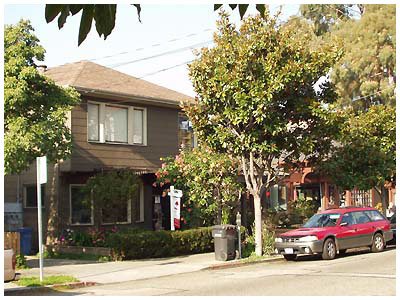
The Skotos House. But, I'm supposed to be talking about Skotos and online games, so let me introduce you to the Skotos office. It's the brown-shingle house here, hidden mostly by a tree. When we originally conceived the layout of the house, engineering and game design went upstairs, administration and customer support went downstairs, and the computers went in the basement. Things have changed a lot in the couple of years we've been here, but that's always the case as a business evolves. You might be a bit surprised by our location in a nice old Craftsmen house, but that's what has allowed Christopher Allen, the President & CEO of Skotos, to ensure that the Skotos office had important amenities, such as natural light and fresh air. A positive workspace creates happy employees, and that has benefits all around. (See a logical map I drew of the Skotos House about a year ago.)
|
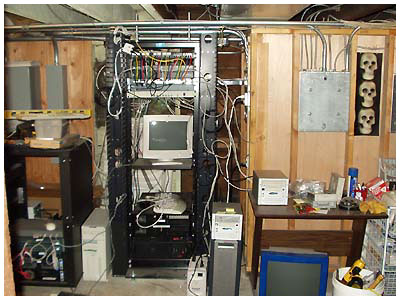
The Machine Room. Running an online game isn't as easy as writing the game, then turning it on. You need a place for the game to run too. Here are a rack and a half of machines located in the basement of the Skotos house. To the right is our main rack, containing the Marrach and TEC/GR machines, as well as some other stuff (I honestly can't keep track of all the machines we have right now) and to the left of that is a rack containing some machines owned by "Unplugged Games", one of our friends.
|

Our Generator. I've talked before about how guaranteeing uptime for an online game is quite a bit of work. This here is one of the things that helps us out at Skotos — a generator which takes over if our power drops out. It's actually even more complex than that. The generator runs on both natural gas, which comes in from PG&E, and on propane, which is stored in tanks, so that even if the city gas goes out, we can keep going. There are some UPSes attached to our important machine too, to keep them up during the few seconds required for an automatic switchover from city power to generator power.
|
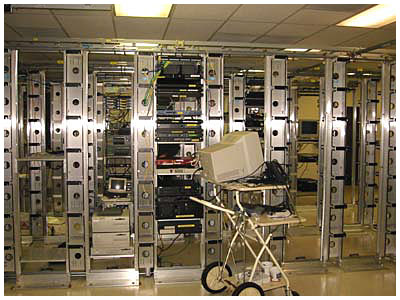
Our Colo Facility. Even if we're able to promise 99%+ uptime for the machines that we directly administer at our office, that's not a high enough guarantee for our web machine, www.skotos.net, which actually tells the world we're alive and acts as a portal to all our games. Thus, we host www.skotos.net over at a colo facility on the other side of the San Francisco Bay. As you can see, the colo facility hosts rows and rows of machines. Ours is actually in the second row, and thus invisible in this picture. Just as we're able to amortize costs by running multiple games, our colo facility is able to offer much higher reliability guarantees by amortizing their costs across many clients.
|
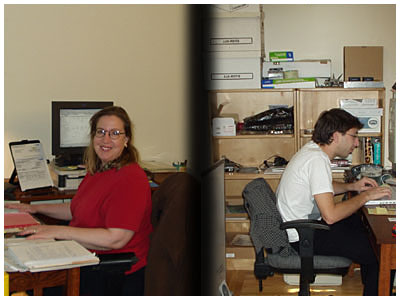
Administrative Staff. Running a game company also requires a lot more than just game designers. Jessica, on the left here, does operations. She's the one that keeps the office running. Dan, on the right here, does sysadmin. He's the one that keeps the machines running. We're still a very small company, though, and so everyone also does a gazillion other tasks. It's Jessica, for example, who processes payments by check, and it's Dan who recently upgraded the authentication in the Skotos forums.
|
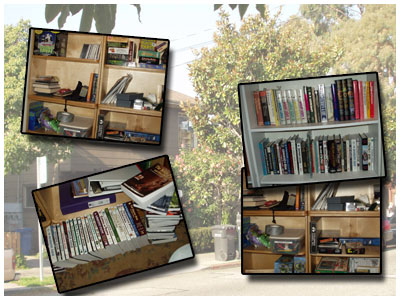
Research, Research, Research. So by now you're probably saying, sure there's a lot of other stuff that goes into running a game company, and some administrative staff who have to do that stuff, but the game designers... they have fun. No doubt there's a certain amount of that, but there's also a lot of hard work. Grinding out room and room. Puzzling over many possible design combinations. Or, doing lots and lots of research to prepare for a game. In these pics you can see just a few of the Lovecraftian books that are influencing Lovecraft Country: Arkham by Night and a few shelves of the games that we occasionally play and analyze to help us think about design.
|
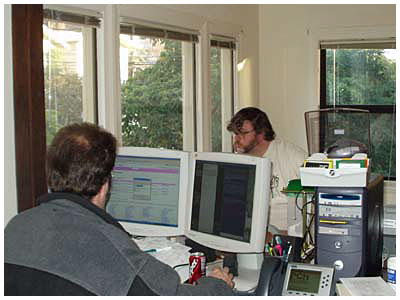
Game Designers. Pictured here are Christopher & Michael, two of our game designers. Christopher is the brain behind Skotos and the core designer & producer for games from Marrach to Lovecraft Country. Michael drew most of the maps you've seen, wrote many rooms is Marrach, and is currently writing rooms for Lovecraft Country. This picture also does a good job of showing that natural light in the Skotos office again. Staff you haven't seen pictured yet include our offsite engineers, our offsite web designer, the folks from Worlds Apart, the many StoryPeople in Marrach, and... me.
|
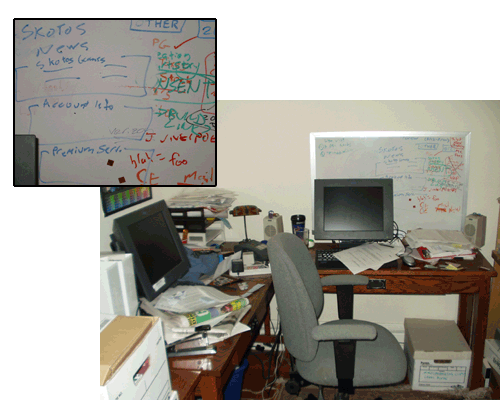
My Desk. Unfortunately I don't seem to be at my chair right now. If you remember my movie script from TT&T #31, I described my desk like this: "Shannon's desk is covered with the typical detritus that comes with the business world: paperwork. A laptop computer rises forlornly amongst the papers, carbon copies, and triplicate forms. Behind it, on the wall, is a whiteboard filled with an extremely long todo list." It hasn't changed a lot. The business world still covers my desk with detritus, and it needs to get done to keep Skotos moving forward. The whiteboard, if anything, has grown more arcane. My favorite thing on the board in this pic is the statement "blah = foo". I have no idea what it means. Notably, this is not the desk where I write TT&T. That gets done at home — because I usually don't have enough free time at work — usually very late at night. (Right now my clock says 1:13 AM.)
|
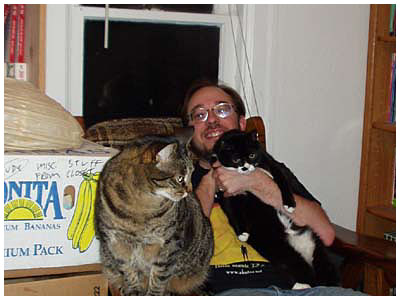
The Columnist Guy. Here's a picture of that guy who's been writing these columns for the last 2+ years. Taken at home, by my wife, alongside our two cats. Every medium has rules, including the medium of photographs. A fairly cardinal rule is that you can strengthen a picture by creating a strong focal point, and you can do that by creating a triangle within your picture. I tried, but our tuxedo cat wasn't cooperative. I guess I should stick to game design.
|
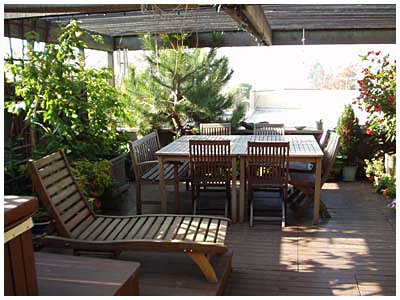
Ending on the Patio. And that, my friends, is Skotos. The place, the people, and the problems that we wrestle with in keeping a game company going. I wanted to end this photocolumn on the deck, which on a clear day overlooks the Golden Gate Bridge. This is where we gathered on the day that Marrach launched, over two years ago. Here's what I wrote about it then, in TT&T #1: "At 10 o'clock or so tonight, Skotos gathered together on our patio that overlooks the San Francisco Bay. We filled glasses with champagne and for a moment gazed out into the night — at the dark ocean, at the dimly-lit sky. Then we raised up our glasses and began to offer toasts — to the people who had made this launch a success, to the future, to Marrach. It was a moment of a community, a moment of fraternity, a moment in which dreams had been fulfilled. Welcome to our dream." If this is your first visit here, let me again say welcome. If you're been a regular visitor, let me say thank you.
|
In a way, today's column is a goodbye. Not to me, or to this column. I'll be back in two weeks with the first new column of 2003, on a totally new topic.
But, it is a goodbye to our old office, and some of what you have seen here, in this week's column. The Skotos House proved to be too large for a company of Skotos' size, and so we're now moving on to new digs (though we're maintaining some of our machine room space and meeting space for the foreseeable future). It's been a great home for three years now, and I'm going to miss it quite a bit, but to each thing its season.
2003 will be a new year, and with #101 I plan to start off a slightly new era in this column. Until then, best wishes, and thank you for reading.
|
Recent Discussions on Trials, Triumphs & Trivialities:
|
|
|
  |
|

 Trials, Triumphs & Trivialities #100:
Trials, Triumphs & Trivialities #100:












